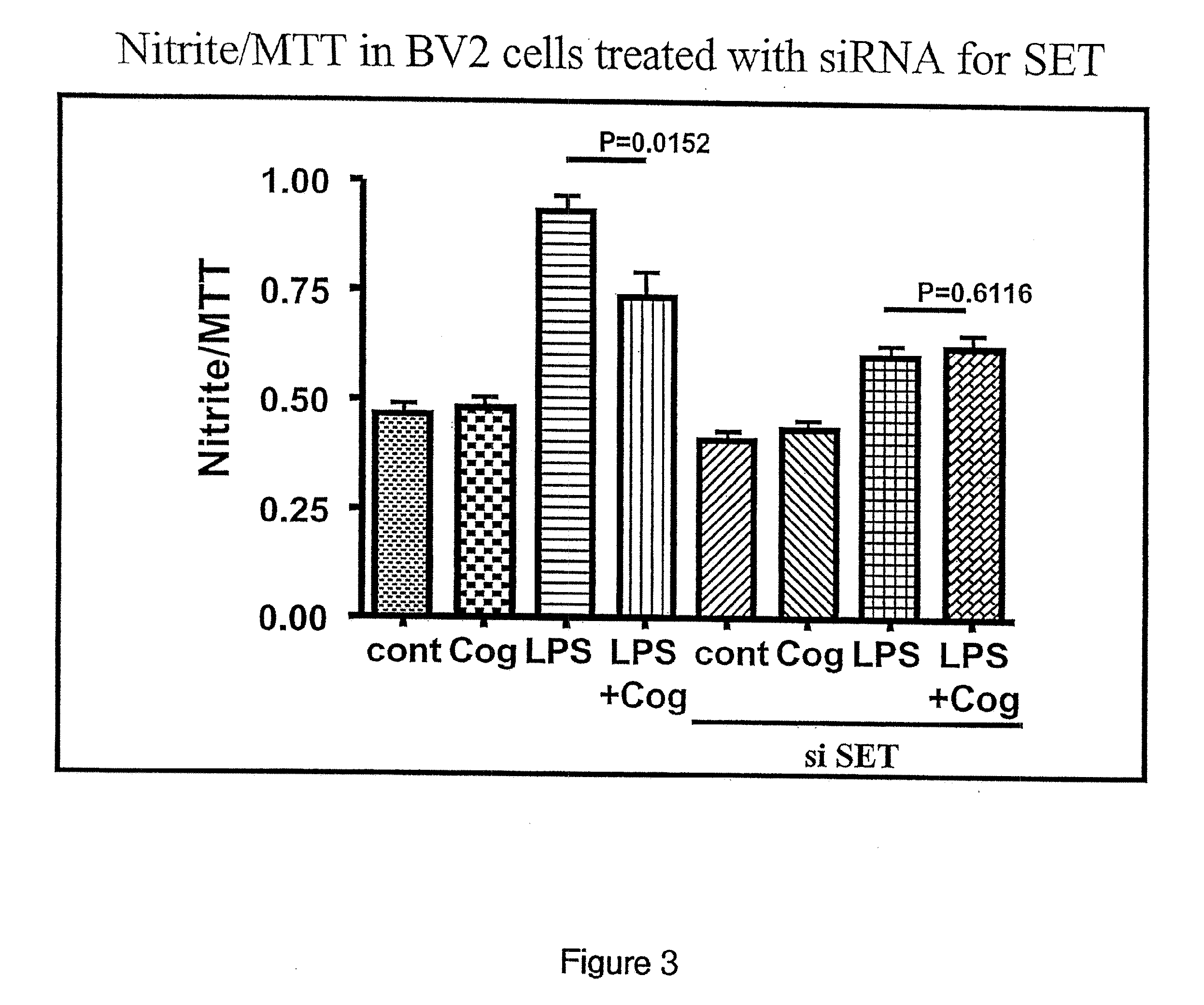Methods for modulating set and uses thereof
a set and activity technology, applied in the field of set activity modulation, can solve the problems of undefined role of apoe in the cns, increased cell death of set function, and unidentified connection between set and apoe, so as to reduce microglial activation, reduce tau hyperphosphorylation, and reduce glial activation
- Summary
- Abstract
- Description
- Claims
- Application Information
AI Technical Summary
Benefits of technology
Problems solved by technology
Method used
Image
Examples
example 1
Identification of SET
[0097]COG 133-biotin or a biotin control was added to total protein from BV2 microglial cells. Proteins binding to Cog-biotin or biotin were collected by immunoprecipitation with streptavidin beads. Beads were extensively washed to remove non-specifically bound proteins. Proteins specifically bound to the streptavidin were eluted and denatured with laemmli sample buffer and run on an SDS / PAGE gel. After electrophoresis, the gel was stained by coomassie / silver stain to visualize protein bands.
[0098]FIG. 1 provides a silver stained image of the SDS / PAGE gel and results of the experiment. The COG-biotin lanes labeled A and B contain two bands not present in the biotin control lane of the gel. Silver stained bands containing the COG 133-binding protein were excised from the gel, and protein was extracted from the gel slices, digested with a protease like trypsin, and the proteolytic fragments analyzed by mass spectrometry. The sequence of selected proteolytic fragme...
example 2
COG-Biotin Interacts with SET Protein Directly
[0099]BV2 microglial cells were cultured and contacted with biotin labeled COG 133. Total protein extracts were prepared from treated BV2 cells and biotin-containing complexes isolated with streptavidin-agarose beads. After washing of beads, proteins were eluted by boiling in Laemmli sample buffer and denatured proteins were separated on a SDS-PAGE gel. Proteins separated by SDS-PAGE were transferred to nitrocellulose, and Western blots probed with anti-SET antibodies. Blots were washed to remove non-specifically bound primary antibodies. The blots were then incubated for 1 hour with goat-anti-rabbit / horse radish peroxidase-coupled secondary antibodies followed by washing and development with a chemiluminescent HRP-antibody detection kit (Denville Scientific). Blots were exposed to x-ray film for various lengths of time. Immunoreactive bands were visualized as dark bands on the film.
[0100]FIG. 2 provides a blot image and legend. The firs...
example 3
Nitrite / MTT in BV2 Cells Treated with siRNA for SET
[0101]COG 133 has previously been shown to reduce LPS-induced nitric oxide production (Lynch et al. 2005). See PCT application PCT / US05 / 31431 which claims priority to U.S. Provisional Applications 60 / 606,506, filed Sep. 2, 2004, 60 / 608,148, filed Sep. 9, 2004, and 60 / 606,507, filed Sep. 2, 2004 which are herein incorporated by reference in their entireties. BV2 cells were transfected with siRNA to SET. BV2 cells transfected with the siRNA and BV2 cells not transfected with the siRNA were treated with COG 133, LPS, or LPS and COG 133 as described in the above-referenced patent applications. Untreated BV2 cells were used as a control. FIG. 3 is a graph of the results. Bars three and seven correspond to LPS without siRNA to SET and with siRNA to SET, respectively. Bar seven shows a significant reduction in nitric oxide compared to bar 3, thus demonstrating that LPS-induced nitric oxide production is reduced when the amount of SET is re...
PUM
| Property | Measurement | Unit |
|---|---|---|
| cell shape | aaaaa | aaaaa |
| ligand displacement assay | aaaaa | aaaaa |
| fluorescence polarization | aaaaa | aaaaa |
Abstract
Description
Claims
Application Information
 Login to View More
Login to View More - R&D
- Intellectual Property
- Life Sciences
- Materials
- Tech Scout
- Unparalleled Data Quality
- Higher Quality Content
- 60% Fewer Hallucinations
Browse by: Latest US Patents, China's latest patents, Technical Efficacy Thesaurus, Application Domain, Technology Topic, Popular Technical Reports.
© 2025 PatSnap. All rights reserved.Legal|Privacy policy|Modern Slavery Act Transparency Statement|Sitemap|About US| Contact US: help@patsnap.com



